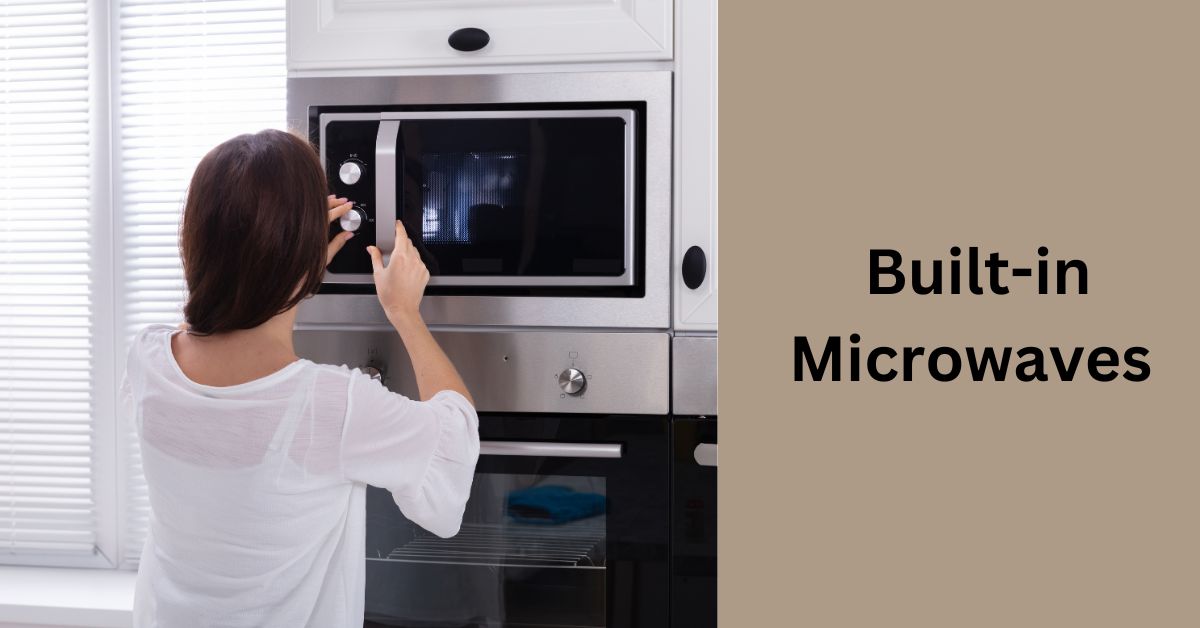Table of Contents
Note: If you came to this post on built-in microwave ovens through a random search, please click on this parent page and our home page for more context.
Built-in Microwave Discussion
In this discussion of built-in microwave ovens, we have excluded microwave drawers and over-the-range microwaves. Both of these are considered built-in but are very different from the standard built-in microwave that we are discussing here.
Please see these related posts:
- Related post: Countertop Microwaves
- Related post: Over-the-Range Microwaves
- Related post: Drawer Microwaves
- Related post: Microwave Ovens
Where to Install a Built-In Microwave
The reason to have a built-in microwave is to avoid it cluttering up the counter and looking ugly. And you want your kitchen to look and function better than it would with a countertop microwave.
Before we get too creative about this, let’s start with the basics.
Kitchen Work Triangles and Work Zones
Don’t forget the time-tested kitchen work triangle. This places the kitchen sink, range, and refrigerator in an easy-to-use relationship. The theory was developed in the 1940s around a single cook.
The principle still applies but has been expanded into work zones. This is because the modern kitchen has evolved into a bigger space with multiple people using it at the same time.
- Related post: Kitchen Layout
The lesson is that a frequently used appliance, such as the microwave should also be easy to access.
Ease of access doesn’t just apply to the placement of the microwave in the floor plan of the kitchen. You also have to consider its height above the floor.
Ergonomic and Safety Criteria for Built-In Microwaves
- For ease of use, the height of the floor of the microwave should be between 10 inches above and 2 inches below the elbow of the primary user.
- For safety, the microwave should be no higher than the shoulder of the primary user
The ADA (Americans with Disabilities Act) has different requirements. These are that the bottom of the microwave cutout should be no less than 15 inches and no more than 37 inches above the floor.
By the way, this is part of what makes the microwave drawer such a good option for a built-in microwave.
So it’s not smart to get too cute when thinking about places to put your microwave.
That said, there are a bunch of built-in microwave location options – some good, some not so good.
A not-so-good option is to hide it away in a pantry. But that totally goes against the kitchen work triangle or work zone principle.
So let’s take a look at locations where we can apply the principle.
Over-the-Range Microwave
The over-the-range microwave is a great space-saving option. However, you need a special type of microwave oven that incorporates a built-in range hood for venting the range itself.
The downside of this is that the venting capability of this type of microwave is very limited and you should not use it over a high BTU range.
A further downside is that this is not a great location for short people or people lacking upper body strength. From a Universal Design standpoint, nobody should be lifting anything hot and heavy above shoulder height.
- Related post: Kitchens for the Elderly
Under-the-Counter Microwave
Placing a microwave under the counter, including island and peninsula counters, is a great location but not, in our opinion, for a standard front-opening microwave oven. This is because you have to stoop to read the display and see what is going on inside.
For this location, you are much better off with a purpose-made microwave drawer. We have covered this in detail. See our post on drawer microwave ovens linked above. However, these are quite expensive.
Microwave in the Upper Kitchen Cabinetry
The microwave can either be exposed by itself on a shelf, behind a cabinet door, or associated with other kitchen appliances as part of an “appliance wall,” or just in combination with a wall oven. Here are some things to bear in mind.
Think twice before putting it behind a cabinet door. It just makes it harder to access.
Besides, you should not put a regular countertop microwave in a cabinet. You may see this contradicted elsewhere by people recommending 3-inch clearances all around but it is a very bad idea. Here’s why:
- A countertop microwave has vents that are built into its back. If you stick it in a cabinet without a trim kit, the vents can get obstructed and won’t be able to release heat and steam. This is a potential hazard.
- Besides, even if you take into account all the air clearances other people may recommend, it will damage your cabinetry over time. This arrangement looks ugly and unfinished too.
So, if you do get a countertop microwave make sure it has a trim kit so that you know it is fit for the built-in purpose.
By the way, do not get a wall oven and microwave combination unit. The microwave component is guaranteed to “die” before the wall oven and this causes an expensive problem. If this location is your preference, get a separate but complementary wall oven and microwave.
Two Types of Built-In Microwave Ovens
The two types of microwaves that can be built in are:
- The true built-in: these are purpose-made for a built-in application and are designed for standard cabinet widths of 24, 27, and 30 inches. They have unfinished sides, so they are not suited for your countertop.
- The countertop microwave with a trim kit. This is usually the least expensive of the two. The trim kit frame provides a built-in look and it is paired with a duct to provide necessary airflow. You have to order the trim kit separately. Here is an explanation of the trim kit.
Some Built-In Microwave Oven FAQs
How much does it cost to install a built-in microwave?
It all depends. Here are the things you have to take into account:
- The cost of the microwave unit itself
- The cost of labor at between $50 and $100 per hour
- Whether you will need an electrical circuit or outlet. This could add up to around $400 to the total cost.
- Whether you need to do extensive modifications to your cabinetry or add a new cabinet
When you put all that in perspective, you don’t want to cheap out on the microwave itself.
What are the pros and cons of convection microwaves?
Pros:
Convenience and space saving because they are a combination of two appliances
- Faster cooking
- Very quick to preheat
- Cheaper to run than a regular oven
- Great for fast reheating and browning
- Versatile cooking applications
Cons:
- Small cavity so cooking is more limited than with a regular conventional oven.
- Can be difficult to clean and keep clean.
- Unless you are careful, it can be easy to overcook food.
Built-in Microwave Ovens on Amazon
- Related post: Kitchen Cabinets






Leave a Reply